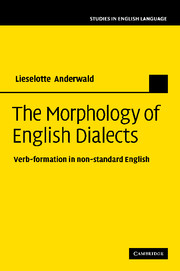Book contents
- Frontmatter
- Contents
- List of figures
- List of maps
- List of tables
- Preface and thanks
- Acknowledgement of sources
- 1 Introduction
- 2 Past tense theories
- 3 Naturalness and the English past tense system
- 4 Sellt and knowed: non-standard weak verbs
- 5 Drunk, seen, done and eat: two-part paradigms instead of three-part paradigms
- 6 Come and run: non-standard strong verbs with a one-part paradigm
- 7 Conclusion: supralocalization and morphological theories
- Appendix 1 Verb classification
- Appendix 2 SED localities and list of counties
- Bibliography
- Index
4 - Sellt and knowed: non-standard weak verbs
Published online by Cambridge University Press: 30 July 2009
- Frontmatter
- Contents
- List of figures
- List of maps
- List of tables
- Preface and thanks
- Acknowledgement of sources
- 1 Introduction
- 2 Past tense theories
- 3 Naturalness and the English past tense system
- 4 Sellt and knowed: non-standard weak verbs
- 5 Drunk, seen, done and eat: two-part paradigms instead of three-part paradigms
- 6 Come and run: non-standard strong verbs with a one-part paradigm
- 7 Conclusion: supralocalization and morphological theories
- Appendix 1 Verb classification
- Appendix 2 SED localities and list of counties
- Bibliography
- Index
Summary
Jedes Wort has seine Geschichte und lebt sein eigenes Leben. (Every word has its own history and lives its own life.)
(Grimm 1819: xiv, my translation)Introduction
As already mentioned in section 1.1, weak verbs can very generally be considered a common Germanic innovation, although perhaps as many as 2 per cent may have come down from Indo-European, as West (2001: 54) points out. It is generally agreed that the class of strong verbs inherited from Indo-European, mainly characterized by ablaut in the Germanic languages, has been steadily diminishing in all Germanic languages, as verbs have been switching verb classes from strong to weak.
In terms of universal natural morphology, a switch of verbs from strong to weak constitutes a natural development (see section 2.9.1), and is one of the few predictions on verb classes that can be derived from Mayerthaler (1981, 1988). Strong verbs are either minimally iconic, if the meaning ‘Past’ is indicated solely through modulation (e.g. sing — sang), or they are less than maximally iconic, if the meaning ‘Past’ is indicated by the addition of a segment, but through modulation as well (e.g. keep — kept). Weak verbs on the other hand are always maximally iconic (the semantically marked meaning ‘Past’ corresponds to the formal addition of the segment <-ed>, e.g. hunt — hunted).
- Type
- Chapter
- Information
- The Morphology of English DialectsVerb-Formation in Non-standard English, pp. 66 - 97Publisher: Cambridge University PressPrint publication year: 2009



